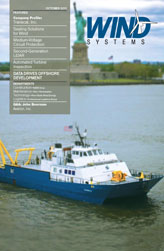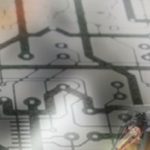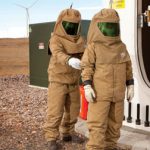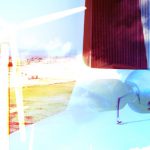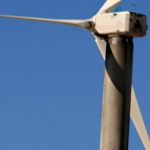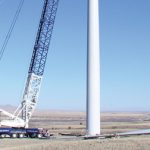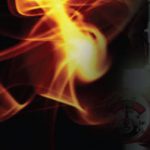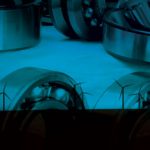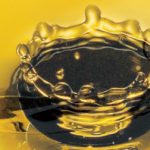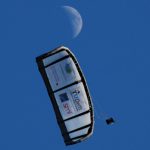With global wind capacity increasing by 22 percent in 2010 alone, according to the Global Wind Energy Council, this budding industry is currently undergoing a period of rapid growth and globalization. To help foster this continued development, suppliers to the wind-power industry need to understand the key trends and challenges associated with generating wind energy.
The wind-power industry must continue to seek new ways to increase the lifespan and reliability of wind turbines. Wind turbines not only require extreme protection against weather and mechanical forces, but also solutions that are long-lived and robust since no one wants to provide maintenance for an offshore system twice a week. As many engineers know, machines are only as good as their parts, and it is often the case that the smallest of components have the potential to have the largest influence on the lifespan and reliability of the entire system. Figure 1
Sealing—the act of preventing something from escaping or entering—is just one example of how a somewhat simple concept can play a critical role in the successful workings of the overall system. From a basic O-ring seal to more complex multi-part sealing systems, the simple act of “keeping something in or out” is a vital aspect in the proper function of wind turbines.
But with sealing, like many other functions within a wind turbine, you are only able to control one aspect of the process: in this case, the seal or sealing system. Other factors such as the counter surface (roughness, hardness), conditions of use (vibrations, shaft eccentricities), environmental conditions (extreme heat or cold), internal media (oil and grease) and so on are uncontrollable, and even unpredictable at times. As a result seal suppliers must recognize and understand these challenges in order to identify and develop the proper sealing solutions for the current and future applications and their accompanying environments.
A Singular Industry
The effort to develop and implement sealing solutions that maximize service life, while also minimizing costly downtime, can be influenced by a number of outside factors including environmental conditions (extreme temperatures, ozone containments, ultraviolet (UV) rays, and salty air) and surface characteristics, as well as external media and lubrication requirements.
Whether onshore or offshore, wind turbines need to withstand large-scale temperature changes. As a result sealing components need to be made with materials that are able to withstand these extreme fluctuations, especially extreme cold, without comprising shape, structure, or sealing ability. This makes the choice of material a critical component in the development of a proper sealing system.
In addition to extreme temperatures, these machines are also subject to a variety of harsh conditions on a daily basis. UV rays that affect a component’s rubber matrix and material characteristics and ozone containments that cause material cracks and breakdown, as well as geographic-specific conditions such as salty air, are all at odds against the proper sealing of a wind turbine. Further, the system’s surface conditions can also impact performance and seal behavior. The accurate evaluation of surface characteristics can provide engineers the needed information to better select or develop the best solution for the given application. Figure 2
Finally, internal media such as the oil and grease used for lubrication pose a particular challenge to sealing systems. Improper lubrication can cause increased friction and wear, which can result in decreased seal life as well as increased maintenance requirements.
To address these conditions wind turbine sealing suppliers are working to advance current technologies, as well as create new designs and systems, to prolong the service life of the overall system. The following will identify four unique wind-power challenges and discuss how sealing suppliers have successfully developed, or are working to develop, solutions to meet these evolving needs.
Wind Industry Challenge #1
• The Challenge: Sealing and protecting the pitch and yaw bearings of wind turbine generators.
• The Obstacles: High-pressure peaks in grease; tight fit (especially at low temperatures); and weather and media exposure.
• The Solution: Next generation material solutions and customer-specific profile seal designs that combine multiple disciplines to achieve the extreme sealing protection needed for this application.
New sealing material and design innovations are driven by the consistently evolving needs of the industry. As a result, there is an array of pitch seal options available to fit the specific geometries of various pitch bearings applications. A crucial element in addressing pitch and yaw bearing sealing challenges is improved materials solutions. Even more than design enhancements, material innovations are key to properly addressing wind-power sealing challenges, as the quality of elastomeric sealing materials is decisive for the functional reliability of the wind turbine generator.
Many factors can influence a material’s sealing ability and the service life of the overall system including mechanical loads, temperatures, greases and other media, ozone, and salt water. As a result, materials for wind-power sealing need to be durable, compatible with oil and grease lubricants, resistant to UV rays, the ozone, salty water, and more.
Two examples of industry-specific material solutions are the newly enhanced line of nitrile butadiene rubber (NBR) Ventoguard™ materials that have been specifically designed to offer superior low compression set (which is a direct measure for its durability as it determines the elastomeric lasting), grease and ozone resistance, and low-temperature capability. Ventoguard 453 and Ventoguard 454 are the next generation of Simrit’s line of established NBR materials designed for use in slewing bearing profile seals in wind turbines. Each material was developed to address a specific wind power-related challenge with the ultimate goal of helping prolong the maintenance cycle of the sealing application. Figure 3
Ventoguard 453 is a premium material that offers excellent cold flexibility, very good compression set, and demonstrates superior aging in several greases, including Klüber, Fuchs, and Mobil. Simrit’s Ventoguard 454, also a new premium material, provides superior compression set and is optimized for use in Shell Rhodina BBZ greases.
In addition to material improvements, a seal’s design is also evolving to meet the sealing requirements of the wind-power industry. As an example, Simrit has developed customer-specific profile seals targeted for large bearing movement that, due to a more subtle sealing lip contour, offers increased flexibility. This flexibility is particularly important as it helps ensure the proper performance during large changes in sealing gap caused by extreme operating conditions—windstorms or strong gusts of wind, for example.
The design incorporated an enlarged sealing bead for the rotating bearing rings, which reduces the profile movement considerably. This next-generation profile provides an enhanced groove fit to also increase the profile’s pressure resistance.
Wind Industry Challenge #2
• The Challenge: Ensuring consistent and reliable sealing of wind turbine transmissions.
• The Obstacles: Long-term, reliable sealing of the critically important main gear transmissions of wind turbines.
• The Solution: Labyrinth seals, a dynamically working seal that uses centripetal effects of fluids to prevent leakage.
Labyrinth seals work as a contactless and frictionless solution that provide extreme service life (20 years in some cases) and require little if any service/maintenance. For decades metal labyrinths have been an established solution for a variety of industries. For the wind industry metal labyrinths have shown to be difficult to assemble, especially at the bigger shaft diameter used in turbines.
One example of supplier innovation is the recently developed polytetrafluoroethylene (PTFE) labyrinth seal, which was specifically designed for large gearbox applications. Simrit is currently the only manufacturer of this type of seal. The Radiamatic RCD seal—which stands for reject, collect, and drain, the three key principles of function in what are known as liquid-collecting labyrinth seals—is a highly efficient solution that offers the prospect of a service life spanning several decades. The seal consists of two parts and features a rotating inner ring and a stationary outer ring. The inner ring is open (optionally) and kept in place on the shaft by springs that adjust to axial movements. The outer ring sits securely in the housing bore. Designed specifically to meet customers’ application requirements, the seal is adaptable to various designs and easy to assemble. Figure 4
The main components of the seal are made of PTFE, which means that they are chemically resistant to additive oils, are ozone resistant and slow to age, all of which are relevant for wind turbine gears. This, in conjunction with the non-contact operation of this sealing solution in wind turbine gears, means that the service life of these seals is expected to last several decades.
Wind Industry Challenge #3
• The Challenge: Preventing the contamination of elements in the main bearing seal.
• The Obstacles: External media such as dust, dirt and salty air.
• The Solution: Innovative designs that incorporate new features, such as dust lips, to address wind-specific challenges.
Simrit worked to examine current designs of competitors to identify and improve their points of weakness. What resulted was the Simmerring Radiamatic R55 seal with a dirt deflector, which combines the main sealing and pre-sealing function into one design.
Previously used in steel mills, the design—which will be introduced to the wind industry shortly—consists of a static part made of rubber and fabric, as well as a seal lip made of rubber and containing a garter spring. The new design is compatible with mineral oils and greases. The solution also offers increased lifetime and better wear resistance, higher chemical, ozone and salty air resistance, and ease of assembly. Figure 5
Wind Industry Challenge #4
• The Challenge: Long-term, reliable sealing for harsh wind environments.
• The Obstacles: Extreme temperatures, dirt and dust, ozone, UV rays, etc.
• The Solution: Development and use of durable materials that extend the life of the seal and system.
One example of an evolved solution that addresses the extreme environmental challenges associated with the wind industry is the Simmerring Enviromatic seal, which offers excellent protection against both dust and salty air. This innovative solution was created using a small line contact of seal lip, contrary to the standard use of V-rings, to guarantee protection of the main seal. Uniquely, the seal operates with the separate functions in individualized, optimized parts.
Working to strengthen the sealing lip of previous V-ring designs, Simrit developed its Enviromatic seal as a premium solution. By incorporating the improved HNBR material Ventoguard 467 and optimizing the design using finite element analysis, the new solution offers improved stiffness, contour, and function that results in more reliable protection and increased wear resistance.
Conclusion
During this time of rapid growth and evolution, wind-power suppliers are tasked with continually driving the development of solutions that address the unique needs of this extreme industry. Adding to the complexity is the sheer size of wind turbines as well as the difficult service conditions, especially in offshore locations.
With the ultimate goal of increasing reliability and lifespan always top of mind, new products and systems need to be expertly constructed and tested, as only the most superior of innovations will allow the wind industry to continue to grow at its current pace.



















